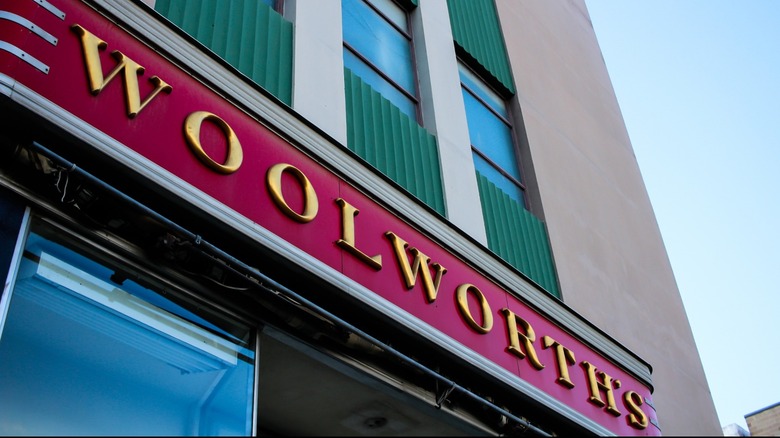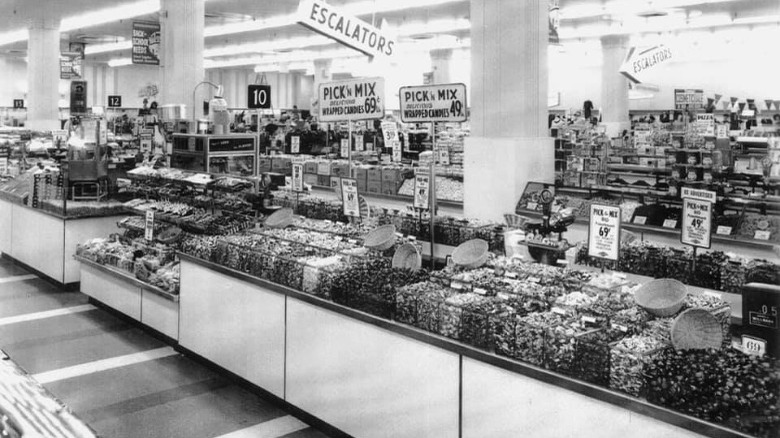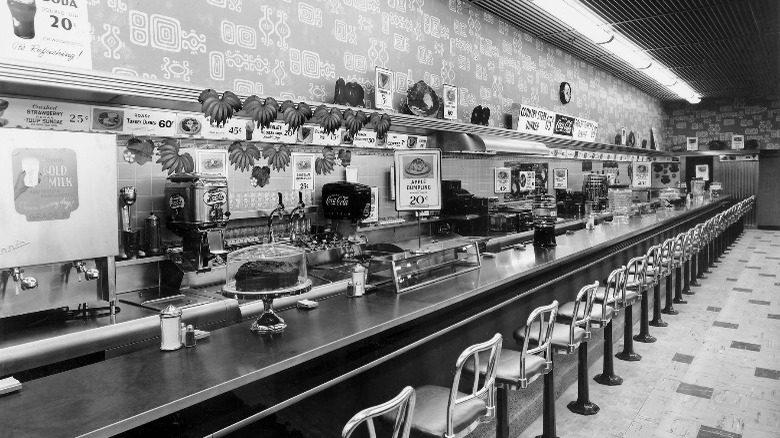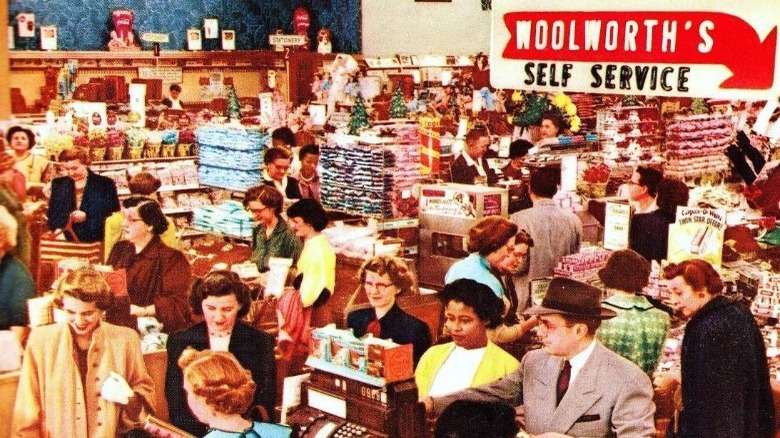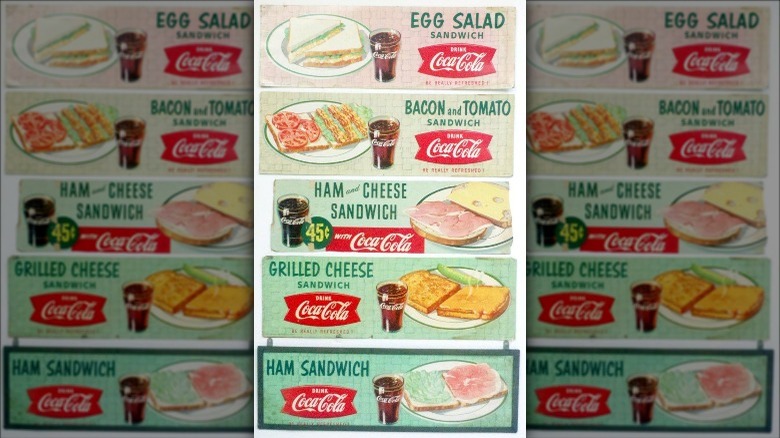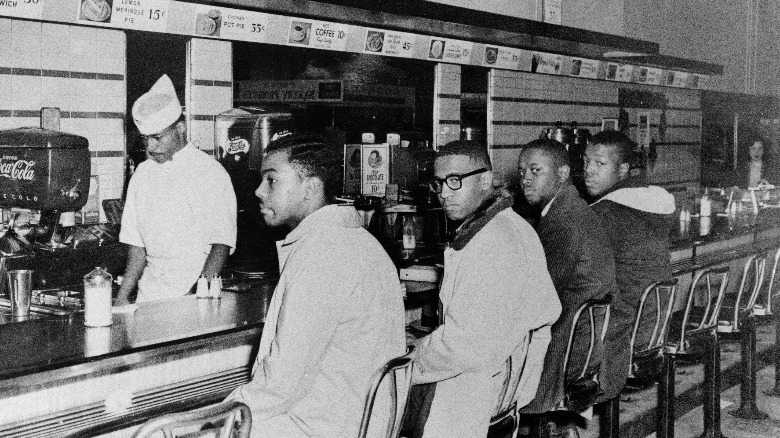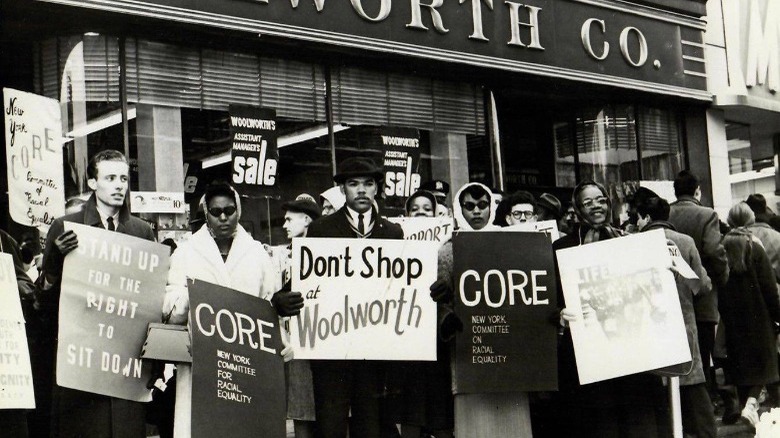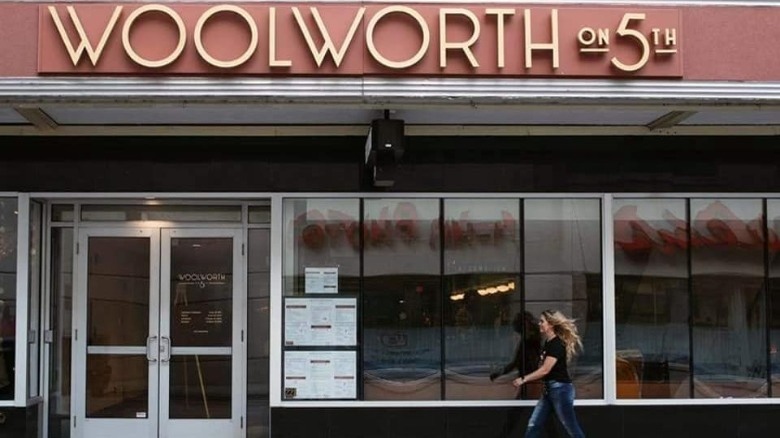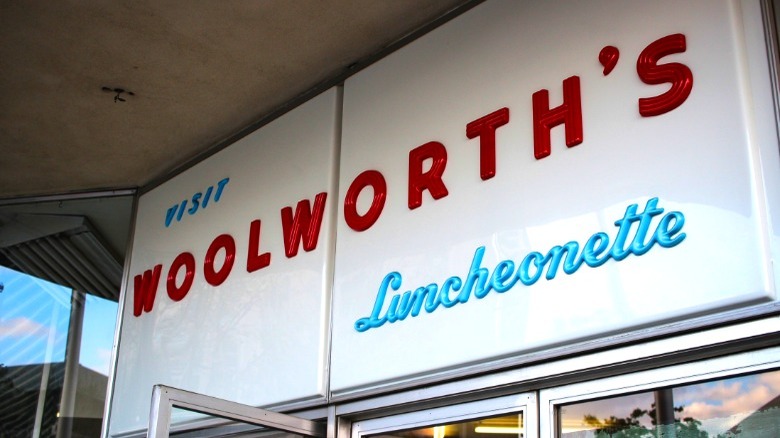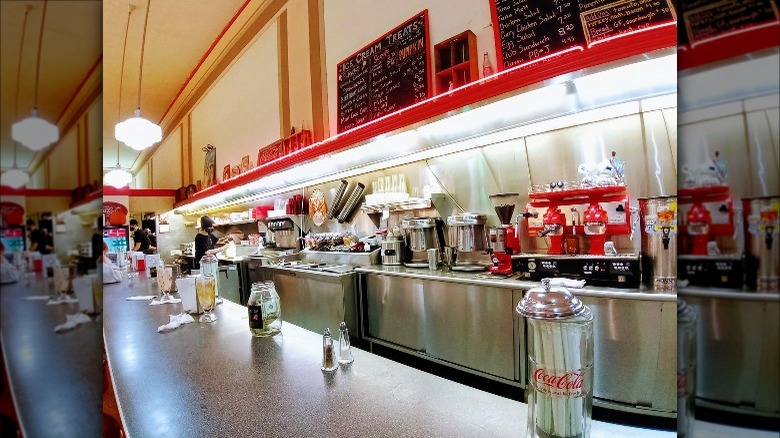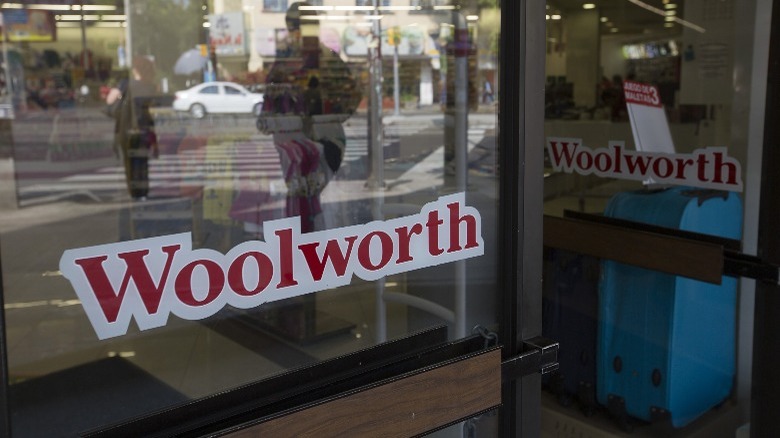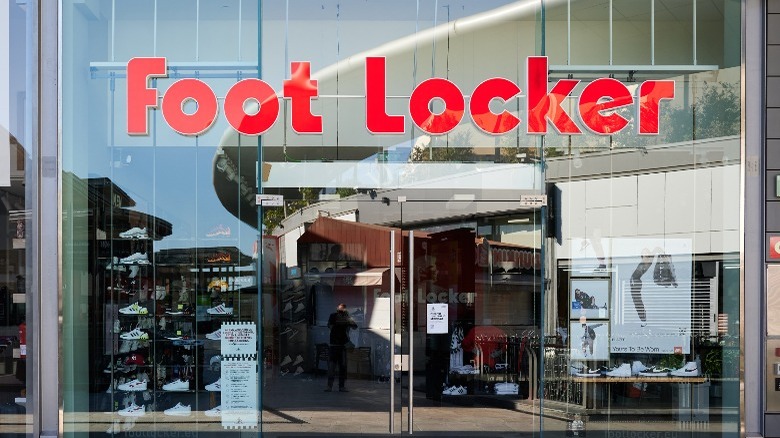The Untold Truth Of Woolworth's Lunch Counters
There was a time in American history when shopping was an all-encompassing experience. Large department stores such as Macy's, Lord & Taylor, and J.L. Hudson provided customers with plenty of the season's best fashions, top-notch appliances, and visually appealing aesthetics that made every moment of an all-day visit special. To further ensure a comfortable and memorable experience for its customers, many of these department stores featured restaurants. In recent times, due to major changes in how people shop, whether that's in a rush or online, in-store restaurants are now few and far between. Per Forbes, some still exist in high-end retail shops, but only in select locations.
Woolworth's was another retail giant of yore that featured in-store dining, though the experience wasn't as bougie as that you might find in a Neiman Marcus. Woolworth's was not a higher-end or even middle-of-the-road store — it was affordable for everyone, including its lunch counter food service. These luncheonettes became widely known and beloved for serving basic hot meals and drinks to parched shoppers and providing a much-needed break space (via The Santa Fe VIP).
But the Woolworth's lunch counters became well known for more than just a moderately priced toasted ham and cheese sandwich and a cup of piping hot coffee. One was even at the center of one of the most prominent civil rights moments in US history. While the physical Woolworth's stores have long closed, it's not entirely gone. This is the untold truth of Woolworth's famous lunch counters.
Woolworth's history began with retail
The F.W. Woolworth Company, popularly known as Woolworth's, was a chain department store that sold almost any item you could think of for an incredibly low price. Founded in 1879 by Frank Winfield Woolworth, the budget store quickly rose in popularity throughout the early 1900s. By 1912 there were over 600 locations. By 1979 it was the top department store in the US. As per Classic New York History, Woolworth's was a catalyst for the modern-era American retail market and was a beloved shopping spot for generations of people.
Woolworth's found success through its boundless assortment of household products from tools, to textiles, to toys and sporting equipment. It also sold plenty of supplies necessary to stock a kitchen, including pie plates, cast-iron pans, cutlery, and more. Woolworth's likewise prospered with its candy sales, placing the sweets near the front door so that customers could easily see the confections and be enticed to purchase some for their children (via Saturday Evening Post).
The goods didn't stop with inanimate objects, either. Woolworth's sold parakeets, hamsters, and even tiny turtles for several decades (via DRLOIH Journal). The mega-retailer operated for 118 years before closing its doors in 1997, saying goodbye to a fading era of lengthy, in-store shopping excursions.
It was famous for its lunch counter
Restaurant-ing Through History notes that lunch counters had been a type of eating establishment since the early 19th century and were added to dime stores in the 1910s. Such expansion provided the store with additional revenue and fed hungry customers, making it a win-win for everyone. Woolworth's made it known that its lunch counters were fresh and modern, it led the way in food safety and sanitation, and was pretty progressive, at least when employing women as counter managers.
According to Restaurant-ing Through History, Woolworth's version of fast food stood out from any competition because of its affordability and good service. Thes tore also sourced ingredients from local dairy and produce farms, getting in on the farm-to-table movement early. Some of the menu offerings included diner-style classics such as sandwiches, salads, rolls, roasted meats, an array of vegetables, and, of course, desserts.
Woolworth's lunch counter was the first of its kind thanks in part to its no-frills approach to food service, a tactic that kept the counter's menu short and simple. The dining space reflected the minimalistic fare and was set up with counter-style seating and sometimes a couple of extra tables (via Ultra Swank).
All items cost five and ten cents
Woolworth's was known as a five-and-dime store — but what does that mean? Simply put, quite literally every product in the store (with the exception of the lunch counter foods) was limited to just five and 10-cent prices. Mr. Woolworth is credited with creating the business model when he opened his first nickel store in Utica, New York in 1879, according to wisegeek. Woolworth's stores were ultimately made unique because of the low-cost lunch counters that appealed to savvy shoppers.
By the time the 1930s came around, comparatively spendy 20-cent products were introduced. Three years later, Woolworth's dropped its price limits entirely (via Classic New York History).
According to Wide Open Country, there were some still scattered five-and-dime stores operating across the United States as of 2019. However, none of the stores are known to have an operating lunch counter, although some do boast a pretty impressive selection of candy.
Real food was served at real low prices
For many, the ultra-affordable food was part of the appeal of a shopping trip to Woolworth's. The Columbus Dispatch reported on the history of its local Woolworth's store, describing with admiration how the hamburgers had been grilled with the same care as they were 50 years prior, topped with lettuce and onion, and served up with an ice-cold Coke. The menu at this location, which was there for 77 years, included hot meals such as roasted turkey with mashed potatoes, fried fish, a baked Swiss steak smothered in gravy, and homemade vegetable soup that only cost 30 cents. In 1969, diners could dig into a steak meal with French fries, salad, and a roll for 99 cents. A glass of lemonade set them back a mere 15 cents.
Of course, this was never going to be gourmet fare for bargain-basement prices. One Woolworth's menu shared by Life In A Skillet shows just how simple the food offerings were with simple meals focused on things like chicken, egg, and ham salad sandwiches, malts, and ice cream sundaes. Still, for many, the lunch counter was the perfect little break spot to rest one's aching feet, set down heavy shopping bags, and enjoy a cup of coffee with a slice of pie.
A Woolworth's lunch counter saw a significant civil rights moment
On Monday, February 1, 1960, four young men — Jibreel Khazan, Franklin McCain, Joseph McNeil, and David Richmond — took their seats at a Woolworth's lunch counter in Greensboro, North Carolina. Per Smithsonian Magazine, the men politely requested lunch service but were refused. The staff cited that Woolworth's policy prohibited Black customers from eating at the lunch counter. Amidst threats of arrest, violence, and even death, the men quietly remained at the lunch counter.
Integration at eateries in the South didn't happen quickly, though the S.H. Kress store in Greensboro allowed all citizens to eat together by the end of the month (via North Carolina History). According to the NPS, more than 150 cities followed suit the next year. The sit-ins also resulted in the formation of the Student Nonviolent Coordinating Committee (SNCC) in April 1960. They went on to lead other historical civil rights actions including the 1961 Freedom Rides and the 1963 March on Washington.
The original Woolworth's store in Greensboro is currently the home of the International Civil Rights Center & Museum (via Civil Rights Trail). A section of the original lunch counter is on display at the Smithsonian. As per Nashville Scene, the Woolworth Theater in Tennessee's capital currently features a window display of an old-school lunch counter setup with a few details that pay tribute to the late Congressman and civil rights activist John Lewis, who participated in sit-ins at the Woolworth's in Nashville.
That wasn't the only sit-in at Woolworth's
The Greensboro sit-in led to more of the same peaceful types of protests at Woolworth's lunch counters and other public establishments across North Carolina and, soon enough, the entire southern United States. Eventually, the public began to boycott Woolworth's altogether in support of civil rights (via North Carolina Museum of History).
Another notable sit-in protest occurred at the Woolworth's lunch counter in Jackson, Mississippi in 1963. The sit-in was initiated by three local African American students, who were quickly supported by more students, both Black and white. According to Teachinghistory.org, the students were attacked by a white mob that had dumped hot coffee and condiments on them while verbally assaulting them. The activist citizens bore the abuse and continued to sit quietly.
One of the protest's leaders, Medgar Evers, was murdered by a member of the Ku Klux Klan only two weeks later. The incident led to intervention by the Kennedy administration, which assisted the city in placing Black police officers in the area. However, the lunch counter at Woolworth's was shuttered to avoid further protests and boycotts. It wasn't until the Civil Rights Act passed in 1964 that the city of Jackson finally abolished segregation. Evers, a decorated veteran who had served in World War II at the Battle of Normandy, was laid to rest at Arlington National Cemetery with full military honors (via NAACP).
Woolworth's downfall began soon after protests
Alongside the highly publicized protests against racial segregation at the lunch counter, Woolworth's faced tough competition with a few names you'll recognize today, including big names such as Walmart, Target, and K-Mart (via Classic New York History). Woolworth's attempted to compete by opening other discount chains peppered around the country, including express stores inside of malls simply called Woolworth Express and another venture dubbed Woolco. Eventually, it changed the Woolworth name to Venator and operated via mail-in catalog orders for sporting goods and other specialty stores.
When all locations finally closed in 1997, SFGate reported that business analysts believed the discount chain had failed long ago and that it was surprising to have lasted so long. In its final year, Woolworth's lost $24 million, losing out bustling suburban areas where newer chains overtook the market. The location in San Francisco was the largest Woolworth's store with a whopping 70,000 square feet of retail space and over a mile of counters. It surely proved difficult to operate with dwindling funds.
In terms of its food service, this store featured two luncheonette areas where hungry customers consumed thousands of hot dogs, pizza slices, and burgers every week, as well as a full deli counter, and a bakery that reportedly sold more than a million donuts per year. Yet, it wouldn't last. According to Ultra Swank, Woolworth's lunch counters were among the first to be hit by financial downsizing when the overall business began to falter.
A Woolworth's diner still exists
If you're mourning the chance to have the lunch counter experience yourself, don't give up just yet. Should you ever find yourself in Bakersfield, California, you may stumble upon a blast from the past in the form of an original Woolworth's lunch counter. Located in an old Woolworth's Building, the vintage luncheonette offers quick bites that include hamburgers, sandwiches, and milkshakes (via Allrecipes). The dining area shares space with the Five and Dime Antique Mall, which helps to give visitors something approximating the old-school Woolworth's experience.
KGET reported on the ongoing process to preserve the luncheonette and place it on the National Register of Historic Places. Built in 1949, Bakersfield's Woolworth's Building is made up of 44,000 square feet of space that's slated for major renovations. Even when new commercial and residential tenants move in, the historic lunch counter will remain.
Dubbed the "Woolworth's Diner", the food served up there is mostly made from scratch and the dining area has remained virtually unchanged since it first opened, all to further preserve its nostalgic past. Roadtrippers reports that minor tweaks have been added over the years, such as a flat-top grill in the 1980s, extra tables throughout, and a gap in the center of the lunch counter so that servers could quickly pass through instead of walking all the way around the one-piece structure.
You can still visit a Woolworth's soda fountain
On the other side of the United States — Asheville, North Carolina, to be precise — is a Woolworth's soda fountain and artistic shopping experience called Woolworth Walk. The original Woolworth's store it's situated in opened in 1938 and received some renovations in 2001 by owner Scott Sirkin. Visitors can not only check out the nostalgic eatery and enjoy a delicious pick-me-up but also take in plenty of local art. The two floors of dedicated gallery space are the largest in the city and include many types of art from over 160 local artists (via Smoky Mountains).
While the soda fountain itself is a recreation of the real deal, the space is original and its menu stays true to what dining at Woolworth's would have been like back in its heyday. Manager Erin Kellem told Mountain Xpress that Woolworth's shops were once a popular meeting place for many people in town.
The Woolworth Walk website features a menu that currently offers simple yet satisfying goodies seven days a week such as classic soups, salads, and sandwiches, alongside dessert treats like ice cream, root beer floats, and, of course, sodas pulled straight from the classically-styled soda fountain.
Some international locations have nothing to do with Woolworth's
According to the Daily Mail, the mega-chain of Woolworth's stores that is currently found across Australia has no legal ties to the original American five-and-dime company. The name has nothing to do with any Australian entrepreneur nor is it a nickname or a random musing that someone had scribbled on a cocktail napkin — it's actually stolen. What is now the second-largest retail market down under was originally created to mirror the popular F.W. Woolworth. Owner Harold Percival Christmas snagged the name because it was never officially registered under trademark in the country. The first copycat store debuted in 1957. Likewise, fake Woolworths in South Africa also lack any relation to the American chain.
The first international location of an authentic Woolworth's opened in Liverpool, England in 1909. By its 50th year of operation, it had 1000 stores across the country (via Woolworth's Museum). However, this subsidiary shuttered its doors in 2008 due to economic woes, Still, a 99-year run isn't bad.
Mexico continues to operate genuine Woolworth's stores, which first came to the country in 1956. According to Forbes, there are a few minor differences from the American ones. Mexico's stores are much larger in size with some featuring multiple floors and lacking the classic lunch counter. However, Mexican locations offer light refreshments such as frozen drinks and popcorn. Today, it's owned by Grupo Commercial Control which manages 36 stores across 25 cities.
Woolworth's eventually became Foot Locker
Maybe we fibbed a little bit when we reported upon the death of Woolworth's. Technically speaking, this chain still exists in the US, though under a very different name. Woolworth's became known as Venator when its business began to deteriorate in the 1980s and '90s. It made a second name change in 2001 to one that you might recognize: Foot Locker (via TheStreet). It all started in the early 1960s when Woolworth's bought the Kinney Shoe Company. It opened the first store under the Foot Locker brand in 1974 in Industry, California. Today, the company runs more than 3,000 locations that span 27 countries. Its sales extend into the tens of billions.
In a recent turn of events, Foot Locker applied for trademark rights to the store's name in 2020. The documents, according to Gerben Law Firm, proved that the sportswear giant intended to bring back the Woolworth's name in some way. However, as of March 2022, there's no evidence suggesting that Foot Locker has made additional moves to relaunch what once was America's most prominent shopping, dining, and historically-significant establishment.
